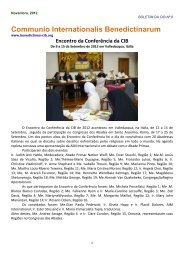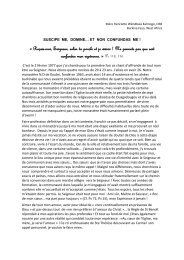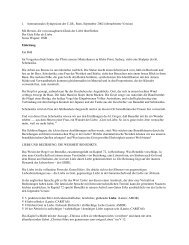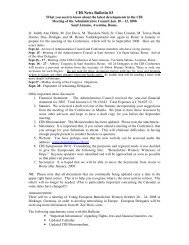Travel Journal by Sr. Vania Maria Toscano - communio ...
Travel Journal by Sr. Vania Maria Toscano - communio ...
Travel Journal by Sr. Vania Maria Toscano - communio ...
Create successful ePaper yourself
Turn your PDF publications into a flip-book with our unique Google optimized e-Paper software.
Possibly we did not have the right directions because we only arrived there at 4:30. The trip was<br />
rather unpleasant with a lot of red clay dust. Also, parts of the road were very rough. The<br />
monastery was simple and modest without the African cultural influences that we had seen in<br />
other locations. We returned <strong>by</strong> a different route, guided <strong>by</strong> a monk in another car. There was in<br />
change in the day´s schedule, as it was not possible to meet with the community that evening.<br />
SEPTEMBER 15<br />
This morning we had Mass with Lauds, followed <strong>by</strong> the closing ceremony. In a few words Sister<br />
Judith Ann summarized basic information about the CIB and introduced the Delegates and<br />
Substitutes who were present. It was a simple, but beautiful ceremony. The CIB candle passed<br />
through the hands of each Delegate or Substitute starting with Mother Henriette, Delegate of the<br />
region that hosted this conference and was returned to Mother Judith who then gave it to Mother<br />
Gian Paola whose region will host the next Conference Meeting in September, 2012 in Italy.<br />
The community then gathered at the church entrance to bid us farewell. After breakfast we were<br />
ready to leave at 9:30. We had been told to deliver our bags to the drivers before Lauds so that<br />
they would have plenty of time to accommodate them on top of the mail van. Even so, it was only<br />
at about 10:35 that we were able to leave for our next destination, which was the city of OUIDAH<br />
on the coast of Benin. It was this city that had been the port of departure for slaves as well as the<br />
port of entry for the missionaries. During the previous day´s conference the Bishop had given us<br />
the news that the Holy Father would be visiting this city and officiating at Mass on November 21,<br />
celebrating the 150 th Jubilee Year.<br />
During our twelve hour journey, we stopped at the Spirituality and Training Center maintained <strong>by</strong><br />
the John of God Congregation in GCOCOTOMEY where we could use the guest facilities. This was a<br />
rare departure from our normal routine of necessary stops along the way where the trees and<br />
bushes had always been our refuge. We passed through COTONOU and at 1 o´clock we arrived in<br />
OUIDAH, where we had intended to go to the seminary for our midday meal. This was not possible<br />
because a road was being built in preparation for the Holy Father´s upcoming visit. However, we<br />
managed access <strong>by</strong> a back entrance and had a large room in the Catechetical Center at our<br />
disposal. There we enjoyed the meal the Toffo community had prepared for us. At 2:10 we left for<br />
a site that preserves the History of Slavery. Spread over this area and close to the beach are seven<br />
monuments honoring the slaves. One monument is called Plaza CHACHA which, translated,<br />
means, “Quickly, Quickly.”. It is calculated that about 6.000.000 slaves were bought and sold at<br />
that site. We saw several different monuments while a guide explained the different phases of the<br />
buying and selling of slaves that every person sold into slavery would have experienced. Among<br />
other explanations, were those about “The City of the Diaspora,” “The House of Zomai,” and the<br />
“House of Darkness” as well as about certain trees and symbols of the resistance. Finally, we<br />
arrived at the “Door of No Return” where the slaves left on boats to be taken to ships out at sea.<br />
Very close to this monument is “The Door of Hope” through which Christianity brought <strong>by</strong> the first<br />
missionaries arrived 150 years ago. Finally, in a great walled space there is a museum, in the<br />
center of which is a very large statue of a woman that represents Mother Africa. Before her stand<br />
two well dressed black persons in western attire meant to represent all those Africans who have<br />
done well in the Americas. This monument represents Mother Africa´s dream of having all her<br />
children back with her, at least for a visit. But, according to our guide, even more than that, she<br />
would like to have them all back to help in the development of Africa.<br />
Page 7 of 9








